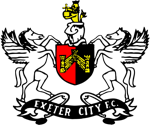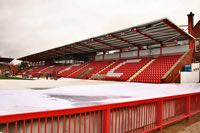
- Home
- Memories
- Scrapbook ▽
- Topics ▽
- People ▽
- Events
- Photos
- Site Map
- Timeline
 Exeter City Football Club - history of the Grecians at St James Park
Exeter City Football Club - history of the Grecians at St James ParkPage updated 25th September 2017
Also see
Sports Clubs and Leisure Centres
Cliff Bastin
Dick Pym
Alan Ball
Michael Jackson
Video
Exeter
City Promoted–at the Guildhall 2008
Exeter City Promoted–at the Guildhall 2009
Exeter City V Norwich City–1930
 The Grecians, as they are
known, were formed with the merger of the Exeter United and St
Sidwell's United teams. St Sidwell's United had formed from the
regulars who frequented the Foresters Inn in Sidwell Street, although
the public house was always known as the Drum and Monkey. When St
Sidwell's beat Exeter United 3-1 in 1904, it was agreed that the two
teams should merge. It was decided to make the combined home of the new
club, Exeter United's pitch, St James' Park, which is situated close to
the Southern Region railway line.
The Grecians, as they are
known, were formed with the merger of the Exeter United and St
Sidwell's United teams. St Sidwell's United had formed from the
regulars who frequented the Foresters Inn in Sidwell Street, although
the public house was always known as the Drum and Monkey. When St
Sidwell's beat Exeter United 3-1 in 1904, it was agreed that the two
teams should merge. It was decided to make the combined home of the new
club, Exeter United's pitch, St James' Park, which is situated close to
the Southern Region railway line.
Lady Anne Clifford, set up a charity in memory of her mother in 1654. A field named 'Mountstephen' would be rented out near St Anne's Chapel to pay 'yearly to the world's end' for supporting an apprenticeship of 'one poor Child, Boy or Girl' who was born in St Stephen. The field was rented out for fattening pigs. The field was also used as an annual camp site for a travelling menagerie–the pigs remained as tenants for as long as 250 years. The terms of the lease allowing football to be played on such hallowed turf stated that "no menageries, shows, circuses or steam roundabouts" were to be allowed, apart of course, Manchester United in 2005! It wasn't until March 1908, that the trustees of the Lady Clifford charity allowed the club to sign a 21 year lease for the ground.
The first combined game of the two clubs was a 2-1 win against the 110th Battery of the Royal Artillery in the East Devon League, watched by a very respectable 600. Originally playing in green and white, the club changed to the more familiar red and white in 1910.
When they entered the Southern League in 1908 and went professional, the club thought it time to build their first grandstand. In July 1914 they lost 2-0 with the Brazil national side, when they toured South America. The First War broke out while the team were steaming home.
They were invited to join the Third Division of the Football League during 1920. In 1921, they sold their goalkeeper Dick Pym to Bolton Wanderers for £5,000, a large sum of money in those days, and they purchased their ground, St James' Park with the proceeds. The Ladysmith School trophy winning side included a young player from Heavitree, called Cliff Bastin. Bastin became a professional City player in 1928 at the age of 17, before being sold to Arsenal in June 1929–he went on to score 178 goals in 396 appearances for Arsenal, only to be passed by Ian Wright in the 1990's. He also went on to play for England, 21 times.
It was in 1925, that the terracing opposite the grandstand was given a roof. It was a short grandstand, as it burnt down soon after, only to be replaced by a new, super deluxe, General Strike delayed, grandstand named the Cowshed, in 1926!
It was in 1931 that the legendary Dido the Seagull first made his appearance for the Grecians, perching on the crossbar during their FA Cup run in which they reached the sixth round, only to be knocked out by Sunderland in the replay at St James' Park 4-2, in front of their largest ever home crowd of 20,984. It was certain that when Dido appeared, Exeter did well. Dido (or his descendants?) appeared from time to time over the following years, to ensure the club kept winning - unfortunately he often had other duties on Saturday, leaving the Grecians to lose a few games. He became so famous that he was immortalised in stone by a Cathedral mason and is now perched on the north side of the Cathedral alongside Bishop Mortimer, who apparently was also a fan.
City were runners up in their League in 1933, when their top goal scorer Fred Whitlow hit the back of the net 33 times. In 1937, City supporters fixed a stuffed Dido onto a pole and carried it through the streets of Preston, prior to their match with the First Division club. It is obvious that a 'stuffed Dido' does not reach those parts that the real Dido does, as they lost 5-3 to North End. It was in November 1946 that Dido was caught by three Exeter City fans and was subjected to a harsh training regime (you know the sort of thing - strutting menacingly, flapping wings and crapping on the opposition goalie!) to get him up to standard for their next away game at Bournemouth, in the FA Cup. Alas, poor Dido was exhausted by the road journey to the match and the unaccustomed exercise, and City lost 5-3.
It was in 1958, that the Fourth Division was created and Exeter where one of the clubs to play from the start.The 1961 season saw a stuffed imposter in a glass case, offered to the club by Miss Hill-Willis of Heavitree Road - City also ended up stuffed that season, being knocked out of the FA Cup by non-league Dartford. It was in the 1963-4 season that saw Exeter promoted to Division Three - this proved to be only a short stay as they slid back to Division Four two years later - guess the pesky Dido was off feathering his nest! Then in 1977, under Bobby Saxton, they went up to the Third again, helped by their prolific striker Tony Kellow who scored 129 goals for the club in total.
They inevitably slid back to Division Four only to be promoted under ex-Leeds United and England winger, Terry Cooper, as manager in 1990. The 1990's were not kind to the Grecians with another slide to Division Four and financial troubles. They tried different managers, including Alan Ball, of the England World Cup Winning side of 1966 but they struggled to make an impression. Then St James Park was sold to Beazer Homes, and the club went in administration in the middle 1990's. In 1996, Exeter City Council stepped in and bought the ground back off the developers, and leased it back to the club. Financial problems continued to add to their woes, and they were relegated to the Conference League under their manager John Cornforth, (my namesake and possible cousin), in May 2003. On the 100th anniversary of the club in 2004, the Brazil national side visited St James Park for a return match which the visitors won 1-0.
Exeter managed a superb 0-0 draw against Manchester United in the FA Cup Third Round on Saturday 8th January 2005. Dido must have given the United team hell!
Unfortunately, in the replay of the 19th January 2005, Exeter lost 0-2 to Manchester United in a match that gave the FA Cup Champions few problems. If Dido had had his full complement of tail feathers, it would have been 3-2 to Exeter.
The Grecians won promotion to League Division 2 after a play off final at Wembley on Sunday 18 May 2008. They beat Cambridge United 1-0 after Rob Edwards scored the winning goal on 22 minutes, a goal that was only his second of the season. The second half was a nerve racking time as Cambridge United pressed forward to get an equaliser, while Exeter squandered a couple of great chances to increase their lead. To get to the final they had two nerve racking games against Torquay United. On 59 minutes of the second game at Torquay, the home side scored making the aggregate 3 - 1 in their favour. All seemed lost, but the lads fought back and scored four goals in 30 minutes to make an aggregate win of 5 - 3 to City. You could say that Dido returned and squashed the Gulls.
In 1908 the club supporters had a vote to adopt a nickname and the old, traditional name for those who lived in St Sidwells won - the name was 'The Grecians'.
There is at least one reference to the name dating from as early as 1669:
"Yesterday, the gardeners and hatters of the number of 300 marched to the works likewise... and this day, 300 Grecians of the Parish of St. Sidwell's... with eight drums, two trumpets, and other sorts of music."
There are several other possible explanations of the origin of the name. One story is that there was a group of kids in St Sidwells who were referred to as the 'Greasy Un's'. A second possible, but unlikely source for the name was a clock that hung outside a jeweller's shop in Sidwell Street, close to the ground, which had the word 'Grecians' engraved or painted on the face.
A third possible source for the name is that it is a corruption of Caerwysc, the Roman name for Exeter. Citizens would have been called Caer Iscuns which became Grecians.
The likeliest explanation is that the local boys of St Sidwell's fought the boys of the city during the annual beating the bounds. The city boys wore blue, the Tory colour and the St Sidwells boys wore the Whig colour, yellow. Because the St Sidwell boys were outside the city wall they were referred to as though they were Greeks outside the walls of Troy. This traditional name was also used in the 19th century, when the plaintiffs in court cases from St Sidwells were referred to as Greeks or Grecians.
There is a Grecian entrance gate at the ground.
Their manager, Paul Tisdale has been in charge of the team for eleven seasons (at 2017), and is the second longest serving manager in the football league. He has a 38% score for wins, 221 out of 580 games. The team has several famous supporters including Chris Martin, Adrian Edmundon and Joss Stone.
Plans are in their final stages to redevelop St James Park, with new stands, and student accommodation to help finance it.
Sources - Exeter City by Mike Blackstone, the Grecian Online website, Exeter Past by Hazel Harvey, Exeter Cathedral, David Walker and my memory. British Newspaper Archive.

The Ivor Doble Stand the pitch has been covered for protection before the 2005 match against Manchester United.
│ Top of Page │